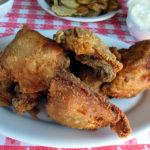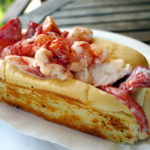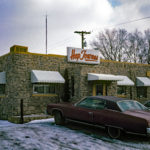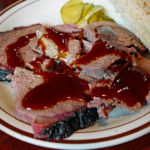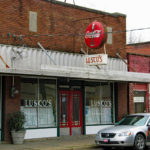Gimme Shelter
After a good day of boldly eating where no food writers have eaten before—truck stops, diners, smoke shacks, even the occasional scurrilous road-house that anchors its chairs to the floor so they can't be thrown through windows—we have to fight the urge to seek out the least interesting place in town to spend the night. We know we aren't the only ones who turn timid at the setting of the sun and begin a hunt for the Ho-Hum Hotel or Bland Bungalows. To a lot of travelers, the prospect of accidentally bedding down in a really bad motel can make the idea of even slightly quirky lodgings fearsome. Spending the night in a horrible hotel is an all-American nightmare that has served as the centerpiece of Orson Welles' s ominous film noir, Touch of Evil, and was the last thing that Janet Leigh did in the scariest movie ever made, Alfred Hitchcock's Psycho.
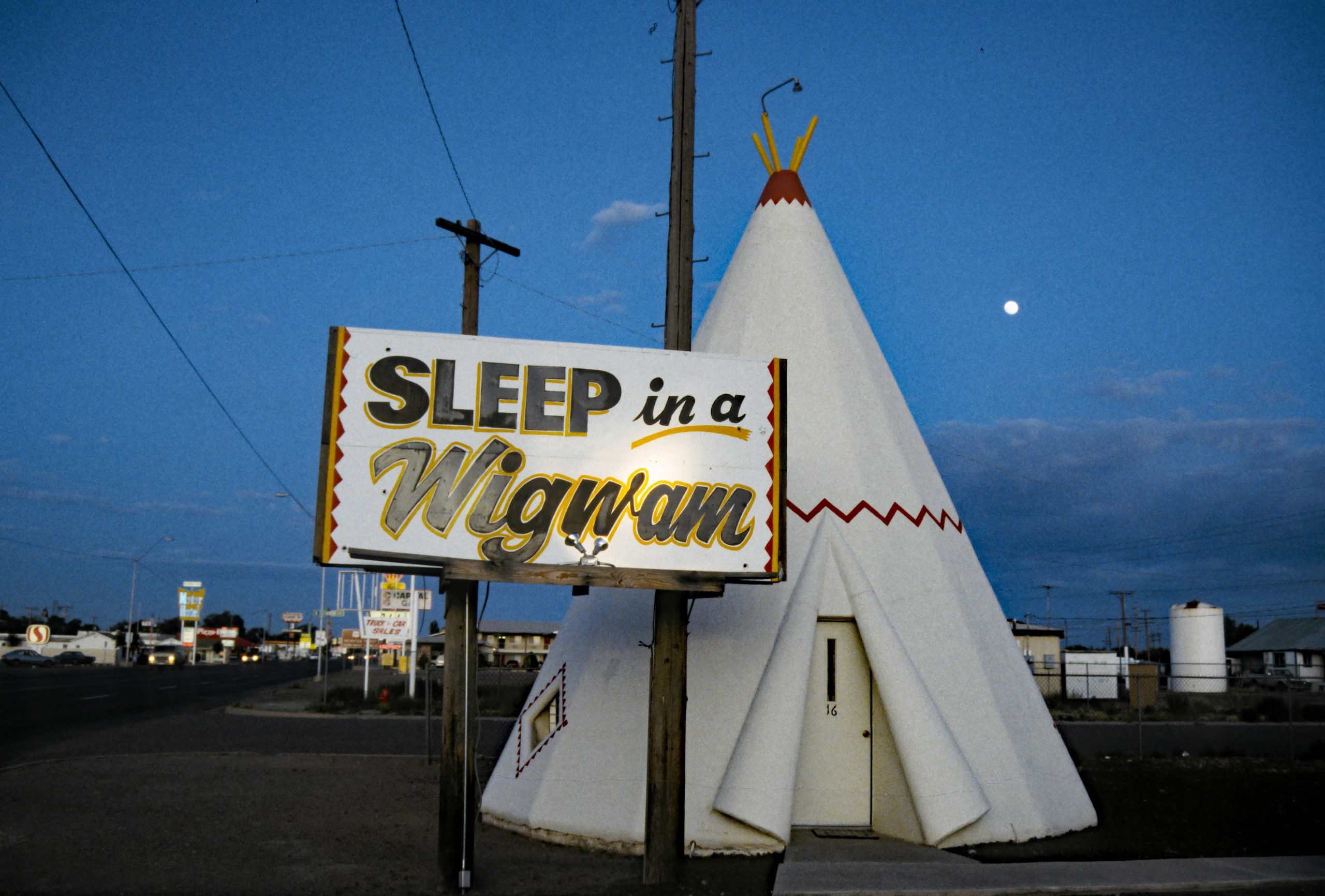
By Jane and Michael Stern
Originally Published 1997 Gourmet Magazine
After a good day of boldly eating where no food writers have eaten before—truck stops, diners, smoke shacks, even the occasional scurrilous road-house that anchors its chairs to the floor so they can’t be thrown through windows—we have to fight the urge to seek out the least interesting place in town to spend the night.
We know we aren’t the only ones who turn timid at the setting of the sun and begin a hunt for the Ho-Hum Hotel or Bland Bungalows. To a lot of travelers, the prospect of accidentally bedding down in a really bad motel can make the idea of even slightly quirky lodgings fearsome. Spending the night in a horrible hotel is an all-American nightmare that has served as the centerpiece of Orson Welles’ s ominous film noir, Touch of Evil, and was the last thing that Janet Leigh did in the scariest movie ever made, Alfred Hitchcock’s Psycho.
Despite our need to be mollycoddled every night on the road, we firmly believe that security doesn’t have to mean a boring, shag-rug, paint-by-numbers-picture-on-the-wall chain motel. In fact, some of our favorite accommodations are anything but bland: snug cabins on the coast of Maine where a moose has been known to poke its head in the window; tranquil teepees on Route 66 in Arizona; a ranchers’ hotel in Fort Worth where you can quaff a longneck beer while seated on a barstool-cum-saddle; and a strange hostelry in southern California where you can sleep on—or technically, in—Cloud Nine.
Such personality-plus roadside lodgings aim to excite their guests’ sense of adventure. From the earliest days of car travel, daring has been the whole point of vacationing on four wheels. Before there were motels, intrepid “automobilists” boasted of the freedom they enjoyed circumventing not only train schedules but the rigid manners and schedules of hotel life by staying in motor camps on the outskirts of town. Then, in the 1920s, came the first roadside cabins to accommodate car nomads who didn’t want to pitch a tent, and a hotelier named James Vail coined a word when he dubbed his “deluxe lodgings” in San Luis Obispo, California, the Motel Inn. With such names as Tumble Inn, Shady Dell, and Para Dice, the pioneering auto havens appealed to travelers’ spirit of romance and whimsy; the more ambitious ones soon began printing lush-colored, linen-finish postcards to advertise their charms. Today, those cards are prized by collectors of roadside ephemera as mementos of a golden age.
The hard times of the Great Depression, however, wreaked ‘havoc on the motel’s reputation. In 1939, a prurient best seller called Teenage Vice! gasped that “a great many of these ‘Cozy Havens,’ Nook O’Rests,”Hyde-A-Wayes,’ and other effulgently named dumps no more want regulation tourist business than a child wants the measles.” Such places, the book warned, were no better than “mobster hangouts,” “assignation houses,” and “blackmailing centers.” The author enumerates a list of infamous motel denizens, including Baby Face Nelson, John Dillinger, and Machine Gun Kelly.
When a Wurlitzer jukebox distributor named Kemmons Wilson took a car vacation with his family in 1951, he was dismayed by the low moral tone and high cost of the hotels they encountered. He knew he could do better, so he built a new kind of motel in his hometown of Memphis, and, paying homage to a favorite wholesome movie, he named it the Holiday Inn. His establishment had none of the quirks of the old motor camps or novelty lodgings, nor did it offer the luxurious amenities of a city hotel. What the Holiday Inn promised was a room that nice, middle-class guests would like, equipped with television, telephone, and do-it-yourself coffee host, plus a swimming pool, a children’s playground, and a chaplain on call. Maids were instructed to open the rooms’ Bibles to a different page each day. Wilson began to franchise his idea in 1954, the same year Ray Kroc bought the rights to franchise a formulaic hamburger stand in California run by the McDonald brothers. The Age of No Surprises had begun.
The overwhelming success of chain motels renders survivors of the early years all the more precious. MOODY’S MOTEL, which opened in Waldoboro, Maine, in 1927 as a three-cabin camp-ground with one shared outhouse, has expanded from the days when moose, partridge, and woodcock hunters paid a dollar a day for their lodging. Today it boasts an all-night diner famous for its blueberry muffins and walnut pie and eighteen spic-and-span white cottages nestled in a peaceful balsam grove on a hill overlooking town. Cabin interiors feature such unaffected mid-century Americana as chenille bedspreads and pole lamps, as well as indoor plumbing and “automatic heat.” Moose are now rare and protected (we swear we saw one at our cabin window in 1978), but the fishing is still great, as is such oldfangled recreation as horseshoes and swing sets. The blazing sunset advertised in vintage 1930s brochures (which list Moody’s telephone number as 1-2-4) is another attraction undimmed by time and progress. There used to be seven Wigwam Villages—cabin encampments built to resemble clusters of teepees—dotted across America. Originally furnished with authentic Navajo rugs and staffed by teams of dancing Native Americans who entertained guests, these themed motels flourished in the 1930s, a time when many vacationers drove away from their city homes in search of a back-to-nature experience. But after World War II, when America fell in love with anything modern, a tourist attraction that offered mere nature and faux-indigenous accommodations was bound to seem passé. Successful roadside enterprises were those with a forward-looking motif: McDonald’s soaring golden arches, Holiday Inn’s twinkle-star billboards, and coffee shops with signs shaped like atoms, rockets, and boomerangs. Few modern American families would choose to spend the night in a musty old teepee when they could be luxuriating on a futuristic Magic-Fingers bed and watching color TV.
Somehow, WIGWAM VILLAGE #6 along Route 66 in Holbrook, Arizona, survived the tail-fin era and the bypassing of old Route 66 by limited-access Interstate 40. Completely renovated in the late 1980s, the motel is today a delightfully nostalgic place for a stopover, and it even has modern comforts. With lodge poles sticking up into a broad western sky, each clean, white stucco teepee is outfitted with television and air conditioning. A sign by the side of the road still exhorts SLEEP IN A WIGWAM, and the gift shop sells petrified-wood curios. Just one problem here: Really tall people may feel a little claustrophobic everywhere but at the very center of their room.
A different memory of the mythic West is kindled by the GADSDEN HOTEL in the border town of Douglas, Arizona. Built in 1907, when pioneers were making fortunes mining and raising cattle, the Gadsden was the finest place new money could buy. A broad Louis C. Tiffany glass mural of desert life extends the length of the mezzanine; vaulted skylights overlook a lobby with a white Italian marble staircase and columns with gold-leaf capitals. Today’s accommodations are less than deluxe, but they are clean and comfortable.
An inspiring rendezvous in which to knock back neat shots of Tequila is the Saddle and Spur Lounge off the Gadsden’s lobby, where cattle barons have congregated to wheel and deal since before Arizona joined the Union. The lounge is dark and clubby, its walls festooned with paintings of brands belonging to ranchers who trailed cattle up from Mexico. To this day, its tables are occupied by men in boots and jeans and high-crowned hats discussing the bovine business in a language that is one-third English, one-third Spanish, and one-third cowboy. And, by the way, we did say shots of Tequila. One time we happened to ask the bartender if he could make a frozen Margarita. “I can…” he replied, with unconcealed disdain for what he no doubt considered a sissy’s drink.
“Just curious,” we said, hoping to salvage our reputations before ordering shots and beers just like the cattlemen around us.
THE STOCKYARDS HOTEL in Fort Worth is outfitted in brass and oak and decorated with cow skulls and elk antlers in a style that has been called “cattle-baron baroque.” To the right of the desk in the lobby is an exhibit of showman Pawnee Bill’s saddle, and, upstairs in the room believed to have been occupied by Bonnie Parker and Clyde Barrow during the summer of 1933, Bonnie’s own six-gun is on display. If it’s the wild, wild West experience you seek, this place—long the nerve center of visiting ranchers, oil magnates, and rodeo and country-western stars with their entourages—is where you want to stay. Located in the heart of the historic Stockyards district, not far from Billy Bob’s honky-tonk and a passel of saddle, boot, and tack shops, this is a whoop-’em-up hotel refurbished to a fare-thee-well and now offering a choice of four different decorating themes in its fifty-two rooms: Indian, Cowboy, Mountain Man, or Victorian. Off a lobby hung with signed 8 by 10 pictures from modern Western celebrities who love staying here, the Booger Red Saloon (named for a Hall-of-Fame bronc rider) offers swiveling saddles on posts in lieu of barstools and serves Texas-made Shiner Bock beer and Llano Estacado wine.
If you need to get away from it all, the Florida Panhandle has an oasis of bygone luxury in a land so magical that Ponce de Leon thought it was the Fountain of Youth when he found it in 1513. Not much has changed in the last half millennium. THE WAKULLA SPRINGS LODGE is a twenty-seven room refuge surrounded by three thousand acres of pristine Florida forest and rivers where alligators bask in the sun and waterfowl and warblers fly above. Built in 1937 on the banks of the freshwater Wakulla Springs, the lodge is a splendid Moorish edifice embellished with wrought-iron grillwork and lavish marble. In the liquid paradise all around it, some guests ride glass-bottom boats so they can peer into the crystalline waters; others hike along trails padded with pine needles. Many come to do nothing at all except enjoy the Edenic peace and quiet of the understated hotel, where there is no cocktail lounge (too raucous!) and no TV in any room.
Nature appreciation on a much grander scale can be indulged at Missouri’s BIG CEDAR LODGE, a complex of Adirondack-style guest houses and individual roughhewn log cabins nestled in the Ozarks’ Big Cedar Hollow. It is a huge enterprise with entertainment for everyone (horseback riding, bass and trophy trout fishing, water-skiing, boating, golf); private herds of buffalo and longhorns to admire; and the bright lights and country music of Branson not far away. Despite all this, it can be as restful as a cottage in a fairytale forest. Every detail fits the rustic reverie: Switch-plates in the guest rooms are portraits of woodland animals; drawer pulls are made of antlers; outside, signs along the road take the form of two-dimensional dogs on point; cabins and trees are strung with tiny lights that sparkle like fireflies. Providing the sort of wilderness fantasy motorists yearned for seventy years ago (when it was built as a sportsman’s retreat)—a fantasy many stressed-out vacationers crave today—Big Cedar is an old-style resort where it seems possible to satisfy any whim, and where members of the staff treat guests like royalty on safari.
Just off Highway 101 south of San Luis Obispo, California, THE MADONNA INN was designed and built in 1958 by construction kingpin Alex Madonna and decorated by his wife, Phyllis. From the outside, with its big native rocks, pink-painted wood, and tiny-pane windows, it looks vaguely like a low-slung nineteenth -century Tyrolean castle or an extravagant villa on an exclusive street in 1940s Bel Air; but to stay in it overnight is to occupy a fantastic world that geography or history cannot explain. Each of The Madonna Inn’s 109 guest rooms has its own unique motif, indicated by the name painted on the door: Love Nest, Pony Room, Austrian Suite, etc. When we say motif, we don’t mean matching pictures on the walls or little fillips of design that suggest the intended idea; we are talking about a delirious take-no-prisoners decorating scheme that defined virtual reality long before the term came into vogue. Style in this place means giddy, all-encompassing surreality. The Caveman Room has walls of floor-to-ceiling rocks; its bed is covered with a faux leopard-skin spread; its shower is a warm waterfall. Although soft, “prehistoric” light filters in through stained glass, there are electric fixtures, as well as television and telephone. The Yosemite Rock Room has green carpeting that resembles moss; in the Cloud Nine Room golden cherubs float through the air; and the Madonna Suite is red and pink with a huge rock fireplace and glittering crystal chandelier—all design elements that echo the glowing aesthetic pandemonium of the inn’s public spaces (which include a dining room with heart-shaped booths of pink leather).
Years ago, when asked why he gave every guest room a different personality, Mr. Madonna replied, “That way we can’t make the same mistake twice.” His incredible roadside landmark is a favorite place to stay for visitors to William Randolph Hearst’s San Simeon, several miles north along the coast. But we warn you: After a night at the Madonna Inn, even the excess of Hearst’s castle seems a little tame.
Big Cedar Lodge
Gadsden Hotel
The Madonna Inn
The Stockyard’s Hotel
Wigwam Village #6
Discuss
What do you think of Gimme Shelter?
Related Articles
Stroud’s
By Jane and Michael Stern Originally Published 1995 Gourmet Magazine Chicken...
The Lobster Roll Honor Roll
Maine is the only state in America that features a picture of cooked food on its license...
Meat-And-Three
A few years back, country singer Ray Stevens invited a New York friend to join him at one of...
Top 12 favorite Ice Cream Scoops
WITH THE EXCEPTION of the hot dog bun, there has never been an edible invention as...
Top 5 BBQ Restaurants | Western Kentucky
Get yourself to Western Kentucky for great BBQ I see the food shows on TV where...
Best restaurants in Greenwood, MS | Hot Licks Delta Style
Ever since we first ate margarine-sauced pompano at Lusco’s, in Greenwood,...

